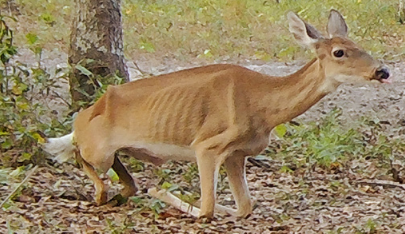
Deer with chronic wasting disease. Credit: University of Florida
By Kelsey Lester
A deer with chronic wasting disease has been found in Ogemaw County — a county that had never seen the disease before.
And that worries the Department of Natural Resources.
Showing zombielike symptoms, the deer was in its final stages of the sickness: drooling, skinny and behaving strangely, according to the DNR.
These behaviors can include running in circles, being more friendly around humans and socializing less with deer.
“Ogemaw County is our northernmost detection in our Lower Peninsula, so it represents a whole new geographic area that we’ve identified the disease in where it previously wasn’t known to exist,” DNR deer biologist Chad Stewart said.
So far, chronic wasting disease, also called CWD, has been detected in 13 counties: Clinton, Dickinson, Eaton, Gratiot, Hillsdale, Ingham, Ionia, Isabella, Jackson, Kent, Midland, Montcalm and now Ogemaw.
Midland County also experienced its first reported case this year, Stewart said.
It typically takes 16 months after infection before a deer shows signs of the illness, according to the New York State Department of Health.
Because the deer found in Ogemaw County was close to death, it likely had been infecting more deer for quite a while, Stewart said.
CWD can infect all members of the deer family by exposure. Michigan has never had a confirmed case of an infected moose or elk, he said.
Stewart said it is important to keep the deer population healthy.
“CWD is an important disease to manage for the long term for the sustainability and health of our deer,” Stewart said. “We don’t want our valuable deer herd to be managed by a disease in 40 or 50 years.”
According to the DNR, chronic waste disease is contagious and “causes the brain of infected animals to deteriorate in a distinctive spongy manner, leading to weight loss, unusual actions, loss of body functions and death.”
While there is no confirmed evidence that CWD can make humans sick, the World Health Organization recommends not eating meat from infected deer.
“It’s so insidious how it can hide in the environment. It makes it difficult to detect and understand a lot about it,” Stewart said.
Because of the infection in Ogemaw County, the DNR is providing more resources and testing sites in that part of the state. The department rotates testing sites around the state each year.
This season’s sites are in Northwest Michigan: Antrim, Benzie, Charlevoix, Emmet, Grand Traverse, Isabella, Kalkaska, Lake, Leelanau, Manistee, Missaukee, Osceola and Wexford counties.
Isabella County is the only one of those to report infected deer.
In contrast to some other states, Michigan’s infection numbers have been rising.
According to Stewart, the state can hopefully slow the effects by supporting science and research.
“I think there’s a way to live with chronic wasting disease in our deer herd and still take responsible actions to help slow the spread,” he said. “There’s a lot of good minds working on it, so I’m still optimistic.”
Kelsey Lester reports for Capital News Service
